Coronary artery outcomes among children with Kawasaki disease in the United States and Japan
- PMID: 23849968
- PMCID: PMC4002741
- DOI: 10.1016/j.ijcard.2013.06.027
Coronary artery outcomes among children with Kawasaki disease in the United States and Japan
Abstract
Objective: It has been claimed that the aneurysm rate for Kawasaki disease (KD) patients in Japan is lower than in the U.S. However it has been difficult to compare coronary artery (CA) outcomes between the two countries because of different definitions for CA abnormalities. Therefore, we compared CA internal diameters between Japanese and U.S. KD patients using standard definitions and methods.
Study design: We retrospectively reviewed CA outcomes in 1082 KD patients from 2 centers in the U.S. and 3 centers in Japan and compared Z-max scores (maximum internal diameter for the left anterior descending or right coronary artery expressed as standard deviation units from the mean (Z-score) normalized for body surface area) obtained within 12 weeks after onset and calculated using two different regression equations from Canada (Dallaire) and Japan (Fuse). We defined a Z-max of < 2.5 as normal and a Z-max of ≥ 10 as giant aneurysm.
Result: The median Z-max for the U.S. and Japanese subjects was 1.9 and 2.3 SD units, respectively (p < 0.001). There was no significant difference in rates of patients with Z-max ≥ 5.0 between the countries. In a multivariable model adjusting for age, sex, and treatment response, being Japanese was still associated with a higher Z-max score.
Conclusion: Previously reported differences in aneurysm rates between Japan and the U.S. likely resulted from use of different definitions and nomenclature. Adoption of Z-scores as a standard for reporting CA internal diameters will allow meaningful comparisons among different countries and will facilitate international, collaborative clinical trials.
Keywords: Coronary artery aneurysm; Echocardiography; Kawasaki disease; Vasculitis; Z score.
© 2013. Published by Elsevier Ireland Ltd. All rights reserved.
Conflict of interest statement
Figures


Similar articles
-
Association of Initially Normal Coronary Arteries With Normal Findings on Follow-up Echocardiography in Patients With Kawasaki Disease.JAMA Pediatr. 2018 Dec 1;172(12):e183310. doi: 10.1001/jamapediatrics.2018.3310. Epub 2018 Dec 3. JAMA Pediatr. 2018. PMID: 30285057 Free PMC article.
-
Differences in Sensitivity Between the Japanese and Z Score Criteria for Detecting Coronary Artery Abnormalities Resulting from Kawasaki Disease.Pediatr Cardiol. 2023 Jan;44(1):153-160. doi: 10.1007/s00246-022-03008-6. Epub 2022 Sep 19. Pediatr Cardiol. 2023. PMID: 36121493
-
Z-score is a possible predictor of the risk of coronary artery lesion development in patients with Kawasaki disease in Japan.Eur J Pediatr. 2021 Sep;180(9):2797-2805. doi: 10.1007/s00431-021-04006-1. Epub 2021 Mar 24. Eur J Pediatr. 2021. PMID: 33763715
-
Epidemiology of Kawasaki disease in Asia, Europe, and the United States.J Epidemiol. 2012;22(2):79-85. doi: 10.2188/jea.je20110131. Epub 2012 Feb 4. J Epidemiol. 2012. PMID: 22307434 Free PMC article. Review.
-
Kawasaki disease: A brief history.Pediatrics. 2000 Aug;106(2):E27. doi: 10.1542/peds.106.2.e27. Pediatrics. 2000. PMID: 10920183 Review.
Cited by
-
Predicting the characteristics of the aetiological agent for Kawasaki disease from other paediatric infectious diseases in Japan.Epidemiol Infect. 2016 Feb;144(3):478-92. doi: 10.1017/S0950268815001223. Epub 2015 Jul 23. Epidemiol Infect. 2016. PMID: 26201398 Free PMC article.
-
Efficacy and Safety of NSAIDs in Infants: A Comprehensive Review of the Literature of the Past 20 Years.Paediatr Drugs. 2022 Nov;24(6):603-655. doi: 10.1007/s40272-022-00514-1. Epub 2022 Sep 2. Paediatr Drugs. 2022. PMID: 36053397 Free PMC article. Review.
-
Coronary Diameters in Taiwanese Children Younger than 6 Years Old: Z-Score Regression Equations Derived from Body Surface Area.Acta Cardiol Sin. 2014 Jul;30(4):266-73. Acta Cardiol Sin. 2014. PMID: 27122799 Free PMC article.
-
Risk Model Development and Validation for Prediction of Coronary Artery Aneurysms in Kawasaki Disease in a North American Population.J Am Heart Assoc. 2019 Jun 4;8(11):e011319. doi: 10.1161/JAHA.118.011319. J Am Heart Assoc. 2019. PMID: 31130036 Free PMC article.
-
Neutrophil-to-Lymphocyte Ratio Predicts Intravenous Immunoglobulin-Resistance in Infants Under 12-Months Old With Kawasaki Disease.Front Pediatr. 2019 Mar 19;7:81. doi: 10.3389/fped.2019.00081. eCollection 2019. Front Pediatr. 2019. PMID: 30941338 Free PMC article.
References
-
- Newburger JW, Takahashi M, Burns JC, Beiser AS, Chung KJ, Duffy CE, et al. The treatment of Kawasaki syndrome with intravenous gamma globulin. N Engl J Med. 1986;315:341–7. - PubMed
-
- Kato H, Sugimura T, Akagi T, Sato N, Hashino K, Maeno Y, et al. Long-term consequences of Kawasaki disease. A 10- to 21-year follow-up study of 594 patients. Circulation. 1996;94:1379–85. - PubMed
-
- Suzuki A, Kamiya T, Kuwahara N, Ono Y, Kohata T, Takahashi O, et al. Coronary arterial lesions of Kawasaki disease: cardiac catheterization findings of 1100 cases. Pediatr Cardiol. 1986;7:3–9. - PubMed
-
- Burns JC, Glode MP. Kawasaki syndrome. Lancet. 2004;364:533–44. - PubMed
Publication types
MeSH terms
Grants and funding
LinkOut - more resources
Full Text Sources
Other Literature Sources
Medical

